Per the earlier Turf Tip, select preemergence herbicides with as little nitrogen as possible to reduce the growth flush and maximize long-term health of the plant. The problem is finding a product with little or no N. Do not make the mistake of settling for a high N product and then reducing the application rate. You’ll also be reducing the rate of herbicide possibly below the effective rate. It might take some looking, but the best place to inquire is at a top quality independently owned garden center. Additionally, LESCO/John Deere Landscapes stores (www.Lesco.com) carry a wide variety of preemergence products with little or no N. These are located in all major metropolitan areas in Indiana and throughout most of the US. Realize though that these stores are primarily for professionals, so container size may be more than a typical homeowner would need. I personally found some preemergence herbicide with no fertilizer in my local Ace Hardware store, so you can never tell where you might find what you need. If you find a selection of products, do some quick math and calculate which product delivers the lowest amount of N, preferably 0.50 to 0.75 lbs N/1000. Also consider the amount of N as slow release which indicates how long the N will release.
|
Step 1. Calculating the pounds of N in the bag |
||||
|
Weight of bag in lbs |
X |
% N (in decimal format) |
= |
lbs N in bag |
|
Step 2: Calculating the rate in N/1000 sq feet |
||||
|
lbs N in bag |
÷ |
Area covered by bag in 1000’s of sq feet |
= |
lbs N/1000 sq ft |
|
Step 3: Calculating percent of N as slow release |
||||
|
% slow release N |
÷ |
% total N |
= |
% N as slow release in bag |
Below are 6 labels from combination products I found in chain retail stores this weekend as well as the calculations for each product. Most of the products contain between 25% and 30% of the N as slow release, which is pretty good. I’d probably buy products 1, 4, 5, or 6 based on their N rate and amount of slow release. I’d avoid products 2 and 3 for sure because they deliver more than 1.0 lb N/1000.
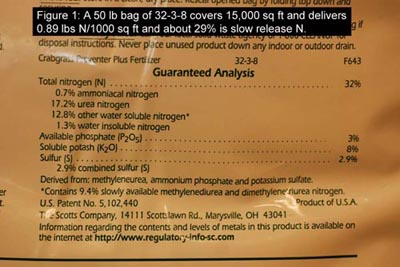 |
Examples
|
||||||||||||||||||||||||||||||
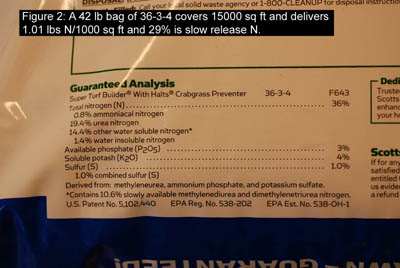 |
Figure 2. 42.18 lb bag of 36-3-4 that covers 15,000 sq ft
|
||||||||||||||||||||||||||||||
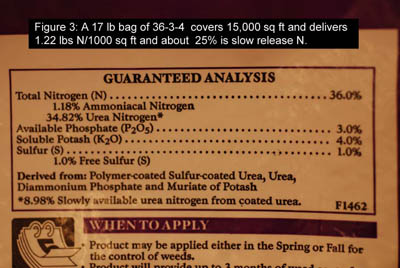 |
Figure 3. 17 lb bag of 36-3-4 that covers 5,000 sq ft
|
||||||||||||||||||||||||||||||
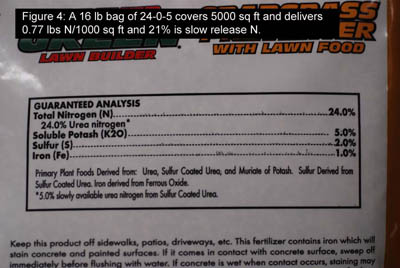 |
Figure 4. 16 lb bag of 24-5-2 that covers 5,000 sq ft
|
||||||||||||||||||||||||||||||
 |
Figure 5. 42.18 lb bag of 30-0-4 that covers 15,000 sq ft
|
||||||||||||||||||||||||||||||
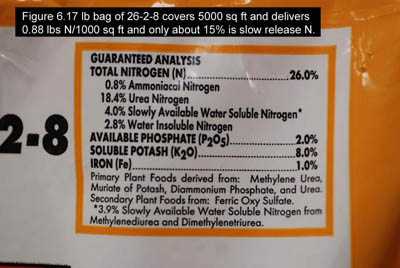 |
Figure 6. 17 lb bag of 26-2-8 that covers 5,000 sq ft
|
||||||||||||||||||||||||||||||